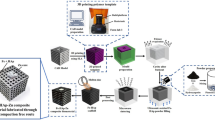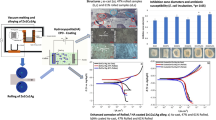Abstract
The conversion of newly developed three dimensionally printed calcium sulfate hemihydrate (70–90% wt/wt CaSO4·0.5·H2O) based materials to calcium phosphate bioceramics by phosphorization in di-sodium hydrogen phosphate solution at 80°C for 4, 8, 16 and 24 h was studied. It was found that transformation rate, phase composition and mechanical properties were influenced by porosity in the fabricated samples and by the duration of the phosphorization treatment. Formulation with 85% CaSO4·0.5 H2O showed the fastest transformation rate and resulted in the highest flexural modulus and strength. Depending on the materials formulation, XRD, FT-IR and EDS revealed that calcium deficient hydroxyapatite (CDHA) or a mixture of CDHA and dicalcium phosphate anhydrous (DCPA) were the resulting phases in the transformed samples. After cell culturing for 14 and 21 days, human osteoblast cells were observed to attach to and attain normal morphology on the surface of the transformed sample containing 85% CaSO4·0.5 H2O. Various sizes and shapes of mineralized nodules were also found after 21 days.













Similar content being viewed by others
Referencess
Chumnanklang R, Panyathammaporn T, Sitthiseripratip K, Suwanprateeb J. 3D printing of hydroxyapatite: effect of binder concentration in pre-coated particle on part strength. Mater Sci Eng C. 2007;27:914–21.
Simon JL, Roy TD, Parsons JR, Rekow ED, Thompson VP, Kemnitzer J, et al. Engineered cellular response to scaffold architecture in a rabbit trephine defect. J Biomed Mater Res. 2003;66A:275–82.
Roy TD, Simon JL, Ricci JL, Rekow ED, Thompson VP, Parsons JR. Performance of hydroxyapatite bone repair scaffolds created via three-dimensional fabrication techniques. J Biomed Mater Res. 2003;67A:1228–37.
Seitz H, Rieder W, Irsen S, Leukers B, Tille C. Three-dimensional printing of porous ceramic scaffolds for bone tissue engineering. J Biomed Mater Res Part B: Appl Biomater. 2005;74B:782–8.
Will J, Melcher R, Treul C, Travitzky N, Kneser U, Polykandriotis E, et al. Porous ceramic bone scaffolds for vascularized bone tissue regeneration. J Mater Sci: Mater Med. 2008;19:2781–90.
Suwanprateeb J, Sanngam R, Suwanpreuk W. Fabrication of bioactive hydroxyapatite/bis-GMA based composite via three dimensional printing. J Mater Sci: Mater Med. 2008;19:2637–45.
Suwanprateeb J, Sanngam R, Suvannapruk W, Panyathanmaporn T. Mechanical and in vitro performance of apatite–wollastonite glass ceramic reinforced hydroxyapatite composite fabricated by 3D-printing. J Mater Sci: Mater Med. 2009;20:1281–9.
Khalyfa A, Vogt S, Weisser J, Grimm G, Rechtenbach A, Meyer W, et al. Development of a new calcium phosphate powder-binder system for the 3D printing of patient specific implants. J Mater Sci: Mater Med. 2007;18:909–16.
Szucs TD, Brabazon D. Effect of saturation and post processing on 3D printed calcium phosphate scaffolds. Key Eng Mater. 2009;396–398:663–6.
Benhayoune H, Jallot E, Laquerriere P, Balossier G, Bonhomme P, Frayssinet P. Integration of dense HA rods into cortical bone. Biomaterials. 2000;21(3):235–42.
Dorozhkin SV. Calcium orthophosphates. J Mater Sci. 2007;42:1061–5.
Gbureck U, Holzel T, Biermann I, Barralet JE. Preparation of tricalcium phosphate/calcium pyrophosphate structures via rapid prototyping. J Mater Sci: Mater Med. 2008;19:1559–63.
Varndran E, Klarner M, Klammert U, Grover LM, Patel S, Barralet JE, et al. 3D powder printing of -tricalcium phosphate ceramics using different strategies. Adv Eng Mater. 2008;10:B67–71.
Igawa K, Mochizuki M, Sugimori O, Shimizu K, Yamazawa K, Kawaguchi H, et al. Tailor-made tricalcium phosphate bone implant directly fabricated by a three-dimensional ink-jet printer. J Artif Organs. 2006;9:234–40.
Gbureck U, Holzel T, Doillon CJ, Muller FA, Barralet JE. Direct printing of bioceramic implants with spatially localized angiogenic factors. Adv Mater. 2007;19:795–800.
Gbureck U, Holzel T, Klammert U, Wurzler K, Muller FA, Barralet JE. Resorbable dicalcium phosphate bone substitutes prepared by 3D powder printing. Adv Funct Mater. 2007;17:3940–5.
Zaman CT, Takauchi A, Matsuya S, Zaman QHMS, Ishikawa K K. Abrication of B-type carbonate apatite blocks by the phosphorization of free-molding gypsum-calcite composite. Dent Mater J. 2008;27(5):710–5.
Ishikawa K, Suzuki Y, Matsuya S, Nakagawa M, Koyano K. Effects of pH on the transformation of gypsum to carbonate apatite in the presence of ammonium hydrogen phosphate. Key Eng Mater. 2006;309–311:199–202.
Furuta S, Katsuki H, Komarneni S. Porous hydroxyapatite monoliths from gypsum waste. J Mater Chem. 1998;8:2803–6.
Lowmunkong R, Sohmura T, Takahashi J, Suzuki Y, Matsuya S, Ishikawa K. Transformation of 3DP gypsum model to HA by treating in ammonium phosphate solution. J Biomed Mater Res Part B: Appl Biomater. 2007;80B:386–93.
Suwanprateeb J. Comparative study of 3DP material systems for moisture resistance applications. Rapid Prototyping J. 2007;13(1):48–52.
Zhou Z, Chen L. Morphology expression and proliferation of human osteoblasts on bioactive glass scaffolds. Mater Sci -Poland. 2008;26(3):506–16.
Dastjerdi MN. Induction of mineralized nodule formation in rat bone marrow stromal cell cultures by silk fibroin. Iran Biomed J. 2006;10(3):133–8.
Acknowledgment
This work was supported by a grant from National Metal and Materials Technology Center, National Science and Technology Development Agency. The authors would like to extend their gratitude to R. Sanngam and J. Jaresitthikulchai for helping in SEM and cell culture work, respectively.
Author information
Authors and Affiliations
Corresponding author
Rights and permissions
About this article
Cite this article
Suwanprateeb, J., Suvannapruk, W. & Wasoontararat, K. Low temperature preparation of calcium phosphate structure via phosphorization of 3D-printed calcium sulfate hemihydrate based material. J Mater Sci: Mater Med 21, 419–429 (2010). https://doi.org/10.1007/s10856-009-3883-1
Received:
Accepted:
Published:
Issue Date:
DOI: https://doi.org/10.1007/s10856-009-3883-1




